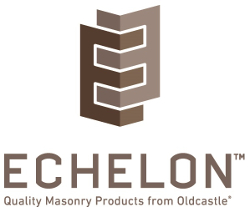Advances in Manufactured Masonry Thin Veneers
Track Systems
Track systems, typically consisting of aluminum shelf brackets, fastening clips, and 1 ¼-inch-minimum-thick masonry panels, are used to hang thin veneer from either a vertical or horizontal application in situations without a conventional perimeter concrete footing to support the weight of the veneer used. Brackets are mounted onto walls, either exterior or interior, as support for masonry panels. Kerfs are sawn in the panels' top and bottom edges so they can be held in place by a railing lip on the brackets and by the fastening clips. Brackets are installed according to a desired coursing design. Next, panels are set in place by fitting their bottom grooves over a length of bracket lip, fitting support clips into the top grooves of the panels, and then tilting them towards the wall to engage the prongs of the fastening clips with the prongs of the support bracket installed above. The installation is completed by inserting backer rod into the panel joints and applying caulk over the backer rod to seal between the panel joint edges.
Prior to installing the bracket system, it is important to assure that the backing wall surfaces are smooth, flat, clean, and free of all debris. Furring may be necessary where the backing wall is not acceptable for direct attachment of the bracket system, and it is the engineer's responsibility to determine the backing wall's structural integrity based on the load imposed by the system panels and other applicable material, live, seismic, snow, and wind-loading conditions. It is important to evaluate not only the structural integrity of the backing wall, but also its capability to resist and drain moisture. Building wrap or other sheathing materials should be properly installed to the wall surface as needed to assure an adequate moisture barrier.
Shims should be used to separate the brackets from the backing wall in order to create a drainage plane for moisture control and to insulate the aluminum of the track from corrosive contact with backing wall materials. While shims may be sized variously to plumb the brackets, it is advisable to assure that the backing wall is as level as possible before the system components are attached.
Insulated Wall System
Another option that is rapidly gaining ground is the foam masonry panel system. These total cladding systems are designed to provide better insulation and consist of foam panels, stainless steel screws or anchors, and mortar, with the foam panel systems able to accommodate a variety of masonry units, including durable stone, clay, and concrete brick with others under development, ranging from larger stone units, stacked stone, and thin brick applications.
These systems take advantage of rigid foam, which has been a key element in energy-efficient buildings over the years as it increases the R-values of the walls with minimal thickness. Because the foam covers the framing elements, and if properly sealed and taped at the seams, the thermal bridging of cavity insulation is often eliminated. As a result, a layer of continuous insulation is provided outside the framing, achieving R-values as high as R-13 and achieving integrated moisture management. Continuous insulation is important because whenever a layer of insulation is interrupted, its effective R-value is reduced.
The foam is the key to the efficiency of the unit and, in addition to its insulation advantage, an effective foam panel will have drainage on both sides to divert any water that may penetrate the wall cavity in order to protect the structure from damage. Recesses in the outside face of the foam form the installation pattern for the masonry units, making for a fast install. Masonry units are friction fit into the pockets and mortar is applied in an injection gun. Some systems use a modified Type S mortar that has been engineered for superior bond strength, adhesion, flexibility, and stability for a long service life.
Foam systems have been proven to resist wind speeds exceeding 110 mph, and placed beneath the masonry surface, foam panels give the wall system an STC rating of 51, which is desirable particularly in multifamily structures as loud sounds will only be faintly heard, leaving occupants with a quiet dwelling. In rigorous testing per NFPA 285 and ASTM E119 standards, these systems have withstood hour-long exposure to temperatures exceeding 1,700°F.
Foam panel systems are essentially an easy install. Door and window openings should first be properly sealed and flashed to ensure thermal and water resistance. After a stable substrate has been achieved, the premolded insulation panels are attached to wood studs or other framing material; best practice is to use manufacturer-provided or approved stainless steel anchors and fasteners. The modular stone or brick masonry units are then installed into place within the insulation panel. The mortar is mixed and applied with a gun or pump. When the mortar is thumbprint hard, it should be tooled with a metal, wooden, or plastic striking tool. Excess mortar should be brushed away.
A Valuable Resource
As advances in every aspect of manufactured masonry thin veneer—from fabrication to shipping to installation—have led to improved products, usage has increased significantly. With a range of striking visual effects, as well as economic and environmental benefits, and ease of maintenance, these products offer architects a valuable resource for interior and exterior applications in structures of all types.
Endnotes
- 1. http://www.businesswire.com/news/home/20110208006008/en/Masonry-Veneer-Products-Experience-Substantial-Growth-2012#.VP4bEfnF-id
- 2. http://www.landscapingnetwork.com/stone-veneer/real-vs-manufactured.html
- 3. http://www.maconline.org/tech/materials/adheredveneer/adheredveneer.html

|
Echelon is the consolidated brand for all masonry products and services of Oldcastle Architectural including Trenwyth® Architectural Masonry, Artisan Masonry Stone Veneers®, Quik-Brik® Concrete Masonry Units, Amerimix® Bagged Goods and a complete portfolio of Performance Upgrades. As a single source masonry portfolio solution, Echelon delivers consistent, reliable product manufactured locally at more than 170 locations and delivered by an unrivaled logistics network. For more information, call (844) 495-8211 or visit EchelonMasonry.com |








